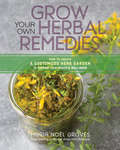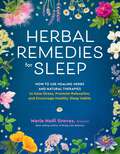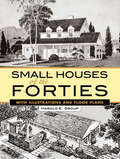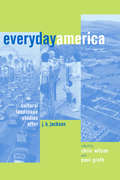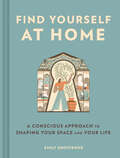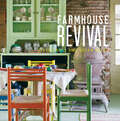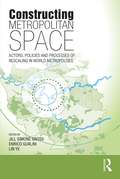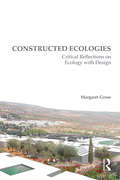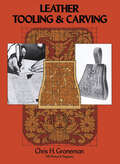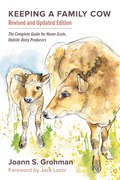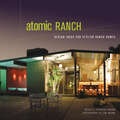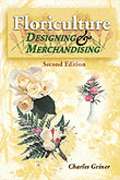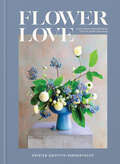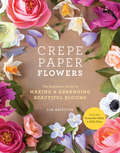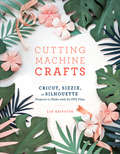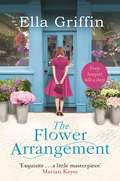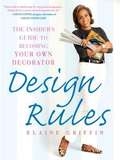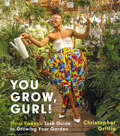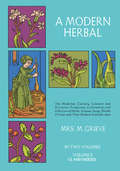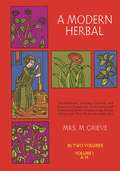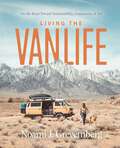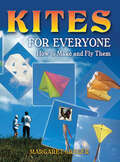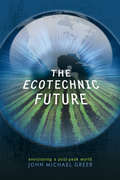- Table View
- List View
Grow Your Own Herbal Remedies: How to Create a Customized Herb Garden to Support Your Health & Well-Being
by Maria Noel GrovesExpert herbalist Maria Noël Groves has advice for budding herb gardeners: grow just what your body needs! In Grow Your Own Herbal Remedies, Groves provides 23 garden plans specially tailored to address the most common health needs, along with simple recipes for using each group of herbs. Discover the three to six herbs that are most effective for what ails you, whether you&’re seeking headache relief, immune support, stress relief, or a simple daily tonic. For chronic stomach problems, marshmallow, plantain, rose, fennel, and calendula make the perfect medicine, with recipes for tummy tea and gut-healing broth. Groves teaches you how to plant, harvest, and care for each medicinal herb, and in all of her plant suggestions, she emphasizes safe, effective, easy-to-grow herbs that provide abundant harvests and can be planted in containers or garden beds. This publication conforms to the EPUB Accessibility specification at WCAG 2.0 Level AA.
Herbal Remedies for Sleep: How to Use Healing Herbs and Natural Therapies to Ease Stress, Promote Relaxation, and Encourage Healthy Sleep Habits
by Maria Noel GrovesEase your stress and finally get a good night's sleep with the help of this guide to the top herbal remedies and natural methods. A good night&’s sleep is the key to good overall health—both physical and mental—but as many as a third of adults say they don&’t get enough of it. The pandemic has led to increased anxiety and stress, making it even more difficult to sleep than it was before. Over-the-counter sleep aids can be habit forming, and many people prefer a more natural approach.Herbal Remedies for Sleep introduces readers to the top 15 herbs for reducing stress and encouraging a good night&’s sleep, along with recipes for using them in homemade formulas. The book includes three classes of herbs: those that have a general calming and relaxing effect; adaptogens, a class of herbs that has grown in popularity for its ability to balance and calm the nervous system; and sedative herbs, for those nights when you just can&’t stop tossing and turning and need to go to sleep quickly. Remarkably, many of these herbs can easily be grown in an ordinary backyard, making it simple for people to grow a garden that helps promote a restful night&’s sleep.
Small Houses of the Forties: With Illustrations and Floor Plans
by Harold E. GroupDesigned for the 1940s family with a "limited budget but unlimited good taste," this fascinating volume presents 56 floor plans and elevations of lovely small homes that originally cost less than $15,000 to build. Each home, bearing the honorable designation of House-of-the-Month by the era's Monthly Small House Club, Inc., was designed to give prospective homeowners an exceptionally well-planned house that was also a sound investment. From Cape Cods to Colonials, Small Houses of the Forties offers an eden of illustrations of cozy, charming domiciles, complete with color combinations, charts, and diagrams. This complete republication of a now-rare volume is also filled with vintage dollars-and-sense information for the postwar homebuyer, including mortgage guidance, amortization schedules, valuations, and construction costs of the times. <p><p> A nostalgic flashback to a simpler American dream of white picket fences, this entertaining and valuable reference will delight architecture enthusiasts, plan collectors, restorers, and historians alike.
Everyday America: Cultural Landscape Studies After J. B. Jackson
by Paul Groth Chris WilsonAs old as a roadway that was once a Native trail, as new as the suburban subdivisions spreading across the American countryside, the cultural landscape is endlessly changing. The study of cultural landscapes--a far more recent development--has also undergone great changes, ever broadening, deepening, and refining our understanding of the intricate webs of social and ecological spaces that help to define human groups and their activities. Everyday America surveys the widening conceptions and applications of cultural landscape writing in the United States and, in doing so, offers a clear and compelling view of the state of cultural landscape studies today. These essays--by distinguished journalists, historians, cultural geographers, architects, landscape architects, and planners--constitute a critical evaluation of the field's theoretical assumptions, and of the work of John Brinckerhoff Jackson, the pivotal figure in the emergence of cultural landscape studies. At the same time, they present exemplary studies of twentieth-century landscapes, from the turn-of-the-century American downtown to the corporate campus and the mini-mall. Assessing the field's accomplishments and shortcomings, offering insights into teaching the subject, and charting new directions for its future development, Everyday America is an eloquent statement of the meaning, value, and potential of the close study of human environments as they embody, reflect, and reveal American culture.
Find Yourself at Home: A Conscious Approach to Shaping Your Space
by Emily GrosvenorExperience magical shifts in your life by redesigning your living space.Home can be a space to explore your sense of self, a message board to cue your aspirational goals, and a story where you choose which parts of your past to put down and which to carry. In Find Yourself at Home, design journalist and interiors consultant Emily Grosvenor introduces her five steps to align your home to suit your purpose and your path: PHILOSOPHY: Connect with the mystery and power of your homeSPACE: Prepare your environment for your storyBUILD: Discover design tools to cue your behaviorDESIRE: Bring your aspirations into your spaceDESTINY: Take your purpose into the world Drawing on ancient wisdom and modern science, along with examples from Grosvenor's groundbreaking research and work with clients, Find Yourself at Home is a philosophical and practical guide to making spatial shifts that will help you cultivate a more meaningful life by shaping your space so it shapes you back.GREAT GIFT FOR HOME DÉCOR MAKEOVER AND FENG SHUI FANS: This is a great gift for people who are looking to rejuvenate their homes, and for those who love home makeover shows, marathoning HGTV shows, and bringing spiritualism and philosophy into their daily lives.A FRESH TAKE ON HOME DESIGN: Many of us have decluttered, home-edited our pantries, tried minimalism, made our homes hygge, and chosen things that 'sparked joy.' Now it's time to shape our homes to reflect who we want to be and our purpose, to make every room align with the behaviors we want to create. This is for readers who are recognizing that our homes have become more than places to rest: they are places for mystery, self-discovery, and empowerment. FOR READERS WORKING FROM HOME/STARTING NEW CAREERS: For many of us, our homes are now also our offices. This is the perfect guide for anyone wanting to bring more of their aspirations, such as focus, creativity, and purpose, into their workspaces.Perfect for:Fans of wellness and those interested in Feng Shui, creating habits, and setting intentionsAnyone looking for ways to make their home reflect who they are and their goals/aspirationsAnyone working from home or starting a new business from homeAn inspiring and practical giftFans of Marie Kondo's books and popular guidebooks such as Joy of Less, Soulful Simplicity, Clear Your Clutter with Feng Shui, The House Witch, and Theology of Home
Farmhouse Revival
by Steve Gross Susan DaleyThe American farmhouse represents integrity, ingenuity, self-reliance, and agricultural heritage. Today, the farmhouse is a rare survivor from another era that can be found sensitively reinterpreted by artists, carefully preserved by original owners, or functionally maintained by farm-to-table artisanal food producers. In more than 200 stunning images, Steve Gross and Sue Daley have painstakingly photographed 20 of the most beautifully preserved farmhouses in the northeast. Some are working farmhouses that have been passed down in families for generations; some have been made productive again by a whole new generation of organic farmers. Still others have been rescued from neglect and restored to their former splendor. Each house is accompanied by an overview of the farmhouse owner and how he or she maintains the property. Fans of the farm-to-table movement as well as historic architecture and preservation will find this an intriguing and beautiful read.
Constructing Metropolitan Space: Actors, Policies and Processes of Rescaling in World Metropolises
by Jill Simone Gross Enrico Gualini Lin YeThere is little question today that processes of globalization affect national and local economies, governance processes, and conditions for economic competitiveness in the major urban regions of the world. In most liberal-democratic countries, these processes are occurring according to a rationale which attempts to combine strategies of state-supported development with increasing local-regional governmental decentralization and autonomy. Against this background, the issue of metropolitan development is being redefined worldwide, along with its institutional frameworks, modes of governance, policy instruments, and spatial planning strategies. The overarching assumption of this volume is that ‘metropolitan space’, far from being consolidated as a policy object, is currently being redefined and in some instances ‘constructed’ and contested as a scale, through a variety of policy practices related to spatial-economic development objectives. Through case studies drawn from across four continents, the authors reveal a range of interesting cross-national commonalities concerning the power that state actors, situated at various spatial scales, exert as agents in these processes. This volume interrogates key research issues raised by these developments, and is intended as a contribution to the establishment of a globally comparative analysis of the construction of metropolitan spaces and scales under conditions of globalization and neoliberalization.
Constructed Ecologies: Critical Reflections on Ecology with Design
by Margaret GroseToday, designers are shifting the practice of landscape architecture towards the need for a more complex understanding of ecological science. Constructed Ecologies presents ecology as critical theory for design, and provides major ideas for design that are supported with solid and imaginative science. In the questioning narrative of Constructed Ecologies, the author discards many old and tired theories in landscape architecture. With detailed documentation, she casts off the savannah theory, critiques the search for universals, reveals the needed role of designers in large-scale agriculture, abandons the overlay technique of McHarg, and introduces the ecological and urban health urgency of public night lighting. Margaret Grose presents wide-ranging new approaches and shows the importance of learning from science for design, of going beyond assumptions, of working in multiple rather than single issues, of disrupting linear design thinking, and of dealing with data. This book is written with a clear voice by an ecologist and landscape architect who has led design students into loving ecological science for the support it gives design.
Leather Tooling and Carving
by Chris H. GronemanThis book by a well-known handicrafts instructor will teach you the fine art of leather tooling and carving so that you will now be able to make the handsomely crafted leather of handbags, belts, watchbands, and billfolds you have often admired. You will find that custom-crafted leather items are not only easier to make than you may have expected but also offer quite an enjoyable hobby.Many books deal with leatherwork in general but this book is one of the few that concentrate on tooling and carving. The author first introduces the various types of leather and tools, giving complete information on how to identify the superior sections of a hide and how to decide on which kind of leather is best for your purpose: kidskin for gloves, steerhide for billfolds, etc. Twenty-six different leather tools are depicted along with an illustration of the impressions the different kinds of stamping tools make. After this necessary background, the author covers the basic processes of leather crafting from start to finish: cutting and preparing the leather, transferring the design, tooling, carving, lacing, cleaning, dyeing, and finishing. This section is profusely illustrated with line drawings and photographs to make each step easy to master. You are now ready to begin the special projects, for which complete instructions and patterns are provided: bookmarks, key cases, coin purses, watchbands, billfolds, belts, shaving kits, camera bags, handbags, and cowboy accessories are just a few of the things you will be able to make.Hand-tooled leather items are quite expensive on the market, but you will find yourself with substantial savings when you make them yourself. What is more important, however, is that leather tooling and carving is an enjoyable craft that anyone can become adept at -- and this book will provide you with all you need to do just that.
Keeping a Family Cow
by Joann S. GrohmanThe cow is the most productive, efficient creature on earth. She will give you fresh milk, cream, butter, and cheese, build human health and happiness, and even turn a profit for homesteaders and small farmers who seek to offer her bounty to the local market or neighborhood. She will provide rich manure for your garden or land, and will enrich the quality of your life as you benefit from the resources of the natural world. Quite simply, the family that keeps a cow is a healthy family. Originally published in the early 1970s as The Cow Economy and reprinted many times over, Keeping a Family Cow has launched thousands of holistic small-scale dairy farmers and families raising healthy cows in accordance with their true nature. The book offers answers to frequently asked questions like, 'Should I get a cow?' and 'How Much Space do I need?' in addition to extensive information on: - The health benefits of untreated milk; - How to milk a cow effectively and with ease; - Choosing your dairy breed; - Drying off your cow; - Details on calving and breeding; - The importance of hay quality and how to properly feed your cow; - Fencing and pasture management; - Housing, water systems, and other supplies; - Treating milk fever and other diseases and disorders; - Making butter, yogurt, and cheese, and, of course . . . - . . . Everything else the conventional dairy industry doesn't tell us! Now revised and updated to incorporate new information on the raw milk debate, the conversation about A1 vs. A2 milk, fully grassfed dairies, more practical advice for everyday chores, and updated procedures for cow emergencies. Keeping a Family Cow has not only stood the test of time, it still remains the go-to inspirational manual for raising a family milk cow nearly forty years after its first publication. Joann Grohman has a lifetime of practical experience that has been bound into this one volume and presented in the spirit of fun and learning.
Atomic Ranch: Design Ideas for Stylish Ranch Homes
by Michelle Gringeri-BrownAtomic Ranch is an in-depth exploration of post-World War II residential architecture in America.Mid-century ranches (1946-1970) range from the decidedly modern gable-roofed Joseph Eichler tracts in the San Francisco Bay area and butterfly wing houses in Palm Springs, Florida, to the unassuming brick or stucco L-shaped ranches and split-levels so common throughout the United States. Authors Michelle Gringeri-Brown and Jim Brown, founders and publishers of the popular quarterly Atomic Ranch magazine, extol the virtues of the tract, split-level, rambler home and its many unique qualities: private front facades, open floor plans, secluded bedroom wings, walls of glass, and an easy-living lifestyle. From updated homes with high-end Italian kitchens, terrazzo floors, and modern furniture to affordable homeowner renovations with eclectic thrift-store furnishings, Atomic Ranch presents twenty-five homes showcasing inspiring examples of stylish living through beautiful color photographs, including before and after shots, design-tip sidebars, and a thorough resource index. Atomic Ranch reveals:Hallmarks of the ranch styleInspiring original ranch homesRanch house transformations and makeoversPreservation of mid-century neighborhoodsAdding personality to a ranch home Yards and landscaping Plus, a helpful resource section and index!
Floriculture Designing & Merchandising (2nd Edition)
by Charles P. GrinerProvides an introduction to the floral industry, along with basic instructions in the techniques of floral design and merchandising. Coverage is at a high school level, using large type and numerous, sometimes fuzzy b&w illustrations of arrangements. Topics range from careers in the retail flower business, design principles, and flower and plant selection and storage, to arrangements for holidays and weddings, pricing strategies, displays, delivery, and professional organizations. Annotation C. Book News, Inc., Portland, OR (booknews.com).
Home Sweet Rented Home: Transform Your Home Without Losing Your Deposit
by Medina Grillo'So many useful tips in here - this is so different to most other books out there!' - Alex Stedman, The Frugality'There seems to be no end of resourceful, affordable and creative ideas.' - Sophie RobinsonYou've got the keys from your landlord, moved into your new home, and the boxes are unpacked. Now you want to put your stamp on the place, but how do you do this when you can't paint the walls, refurbish the kitchen or replace the old, tired flooring?And can you really live with magnolia walls? What about those outdated kitchen cupboards? Not to mention the tattered lampshades, old sofa and sparse furniture...In this invaluable book, award-winning interiors blogger Medina Grillo shares her favourite tips, tricks and DIY projects for transforming a rented space. Discover ways to add a splash of colour with removable wallpaper, learn how to hang artworks without damaging the walls, and turn your hand to upcycling those furniture bargains you picked up at the flea market. With chapters covering all aspects of the home, from walls, flooring and lighting to storage and accessories, Home Sweet Rented Home will enable every reader to make their house feel like home, whether they are a DIY expert or have never before lifted a paintbrush. Filled with photography and illustrations, it is the perfect read for any renter looking to live in a beautiful and stylish home.
Home Sweet Rented Home: Transform Your Home Without Losing Your Deposit
by Medina GrilloYou've got the keys from your landlord, moved into your new home, and the boxes are unpacked. Now you want to put your stamp on the place, but how do you do this when you can't paint the walls, refurbish the kitchen or replace the old, tired flooring?And can you really live with magnolia walls? What about those outdated kitchen cupboards? Not to mention the tattered lampshades, old sofa and sparse furniture...In this invaluable book, award-winning interiors blogger Medina Grillo shares her favourite tips, tricks and DIY projects for transforming a rented space. Discover ways to add a splash of colour with removable wallpaper, learn how to hang artworks without damaging the walls, and turn your hand to upcycling those furniture bargains you picked up at the flea market. With chapters covering all aspects of the home, from walls, flooring and lighting to storage and accessories, Home Sweet (Rented) Home will enable every reader to make their house feel like home, whether they are a DIY expert or have never before lifted a paintbrush. Filled with photography and illustrations, it is the perfect read for any renter looking to live in a beautiful and stylish home.
Flower Love: Lush Floral Arrangements for the Heart and Home
by Kristen Griffith-VanderYachtA playful, approachable guide to a rainbow of flower arrangements from the expert floral designer and host of Netflix&’s The Big Flower Fight.Whether you are new to floristry or have been at it long enough to see carnations come in and out of fashion more times than the mullet, it&’s easy to fall in love and stay in love with flowers. For Kristen Griffith-VanderYacht, flowers are everything—reminders of nature&’s beauty, tools for building creative confidence, and a gateway to self-care.In Flower Love, Griffith-VanderYacht uses his effervescent sense of humor and sharp eye for design to bring accessible, sumptuous floral arrangements to flower lovers everywhere, from all walks of life. With stunning photography of forty-five arrangements, visual step-by-step instructions, and a unique, geometric approach to floral design, Flower Love is an empowering and joyful resource for anyone who wants to add fanciful floral whimsy to their everyday life.This book includes:• Step-by-step instructions for forty-five stunning floral arrangements• The Ten Floral Commandments• The elements of foolproof floral design• Helpful design hacks you won't find anywhere else• A detailed flower glossary organized by color and seasonLearn to source and style lush floral arrangements with this primer on design. All you need are some flowers, scissors, and an appreciation for our planet&’s ubiquitous natural beauty. So, pop on your favorite tunes and give yourself some Flower Love.
Crepe Paper Flowers: The Beginner's Guide to Making and Arranging Beautiful Blooms
by Lia GriffithWith 30 projects and an introduction to both crafting paper flowers and working with crepe paper, this book is full of inspiration and expert advice for beginners. If you have a Cricut Maker, you can download the templates to your machine so you can enjoy your own homemade bouquets in no time.Crepe paper is the best material for creating paper flowers, especially for beginners. It's forgiving and malleable--easy to cut, bend, curl, and shape into peony petals, daffodil trumpets, chrysanthemum blooms, and more. And if you have a Cricut Maker, you can easily cut out the shapes from templates you download for free on Lia Griffith's website using a code. Then, follow instructions for crafting the flowers to arrange and display in vases and pots and as bouquets and wreaths.
Cutting Machine Crafts with Your Cricut, Sizzix, or Silhouette: Die Cutting Machine Projects to Make with 60 SVG Files
by Lia GriffithGet more creative with your Cricut, Sizzix, or Silhouette die cutting machine! Here are 50 easy projects and 60 templates for making gorgeous home accessories, fun party decor, and memorable gifts. This book includes beautiful items you can make using just about any electronic die cutting machine, by downloading the SVG templates, running your materials through your machine, and following the instructions to assemble your cut materials. Discover graphic Scandinavian patterns to decorate aprons and tea towels, paper succulent centerpieces, and dozens of blooms for bouquets, garlands, and crowns. Every project includes easy instructions and plenty of variations so you can get the most out of your machine. With an introduction to electronic die cutting machines and options for cutting the templates out by hand, this book is full of inspiration and expert advice.Includes instructions for downloading 60 SVG cut files compatible with most electronic cutting machines.
The Flower Arrangement: An uplifting, moving page-turner.
by Ella GriffinDrawing together heartwarming characters and a story that will keep you turning the pages, The Flower Arrangement is a captivating tale woven around a Dublin florist.Every bouquet tells a story...And every story begins at Blossom & Grow, a tiny jewel-like flower shop in the heart of Dublin. Here, among the buckets of fragrant blooms, beneath the flickering candles and lanterns, florist Lara works her magic, translating feelings into flower arrangements, changing hearts and lives. Whether its bridal posies, anniversary bouquets or surprise deliveries from secret admirers, Lara arranges the flowers for all manner of life-changing moments. No stranger to heartbreak herself, Lara knows flowers say more than words ever can. But can the flowers that heal the customers work their magic on Lara? The perfect feel-good escapist read for fans of Erica James, Roisin Meaney and Lucy Dillon.
Design Rules
by Elaine GriffinRecipient of the Gold Medal in the Living Now Awards-Home Improvement The essential do-it-yourself guide from one of the top designers in the country that uncovers the secret home design rules used by the pros Many design books are filled with lavish photography of perfect rooms that most of us can only dream of re-creating. Without any practical advice, the look is unattainable. That's where Design Rules comes in. Here, Elaine Griffin, one of the country's 100 top designers (House Beautiful), explains all the practical decorating standards that professionals use behind the scenes to create flowing, balanced, gorgeous design. Packed with helpful illustrations and hundreds of step-by-step tips, Design Rules includes essential advice such as: ?Pick a pleasing color palette (that really works) ?Correctly size their bedsize tables (so they don't tower over their beds) ?Enhance the visual appeal of windowless rooms (so they're not dungeons) ?Design furniture arrangements that function and flow ?Style up even the most forlorn kitchens, baths and yes, basements and laundry rooms (honey, no space is too dreadful to be made ultra fab) ?Brighten up their kitchens with a can of paint and a burst of strategically- placed color (location, location, location!) ?Figure out which styles of furniture go together (there is a rule and it's easy!) ?Make their own personalities shine throughout their homes (because they should) ?And oodles more! Design Rules is for the growing number of savvy, novice home designers who are well-versed in what good design looks like, but need advice on how to translate it into their own home. It is the home design bible people have been waiting for.
You Grow, Gurl!: Plant Kween's Guide to Growing Your Garden
by Christopher GriffinDiscover the joys and self-nurturing benefits of plant parenthood, from learning how to begin building your own lush plant family to getting into those fun tips on how to care for your green gurls, with this beautiful, illustrated guide from the dazzling creator of the @plantkween Instagram account. “We all love some new growth, dahling.”Six years ago, Christopher Griffin was just beginning the plant parenthood journey with one small Marble Queen Pothos. Today, this Black Queer non-binary femme plant influencer known as Plant Kween tends to a family of more than 200 healthy green gurls in the Brooklyn apartment they call home. You Grow, Gurl! is Kween’s fun and fabulous guide to becoming a plant parent and keeping your green gurls growing and thriving.Anyone can be a plant parent! It’s all about TLC—taking the time and energy to focus on a plant’s needs, and ultimately your own. Featuring 200 full-color photos and illustrations, practical instructions and tips—on everything from propagating to measuring humidity to repotting—activities, and stories, this fun and joyful guide shows how to green-up any space and have it serving those lush lewks. Self-care takes many forms and tending to your plants’ needs helps you grow too. In addition to information and advice on plant care, Kween provides meditations, mindfulness activities, playlists, and more to help you practice self-care through plant-care. As Kween says, “We can learn a lot about how we treat ourselves, how we treat others, and how we navigate the world from these green lil creatures.” Healing and growing your heart, body, and soul takes time, love, and focus. Taking care of plants teaches you to apply that same attention and love to yourself and helps you find new pathways to explore on your own botanical adventure to self-love.
A Modern Herbal: Vol. II
by Margaret GrieveIf you want to know how pleurisy root, lungwort, and abscess root got their names, how poison ivy used to treat rheumatism, or how garlic guarded against the Bubonic Plague, consult A Modern Herbal. This 20th-century version of the medieval Herbal is as rich in scientific fact and folklore as its predecessors and is equally encyclopedic in coverage. From aconite to zedoary, not an herb, grass, fungus, shrub or tree is overlooked; and strange and wonderful discoveries about even the most common of plants await the reader.Traditionally, an herbal combined the folk beliefs and tales about plants, the medicinal properties (and parts used) of the herbs, and their botanical classification. But Mrs. Grieve has extended and enlarged the tradition; her coverage of asafetida, bearberry, broom, chamomile, chickweed, dandelion, dock, elecampane, almond, eyebright, fenugreek, moss, fern, figwort, gentian, Hart's tongue, indigo, acacia, jaborandi, kava kava, lavender, pimpernel, rhubarb, squill, sage, thyme, sarsaparilla, unicorn root, valerian, woundwort, yew, etc. — more than 800 varieties in all — includes in addition methods of cultivation; the chemical constituents, dosages, and preparations of extracts and tinctures, unknown to earlier herbalists; possible economic and cosmetic properties, and detailed illustrations, from root to bud, of 161 plants.Of the many exceptional plants covered in Herbal, perhaps the most fascinating are the poisonous varieties — hemlock, poison oak, aconite, etc. — whose poisons, in certain cases, serve medical purposes and whose antidotes (if known) are given in detail. And of the many unique features, perhaps the most interesting are the hundreds of recipes and instructions for making ointments, lotions, sauces, wines, and fruit brandies like bilberry and carrot jam, elderberry and mint vinegar, sagina sauce, and cucumber lotion for sunburn; and the hundreds of prescriptions for tonics and liniments for bronchitis, arthritis, dropsy, jaundice, nervous tension, skin disease, and other ailments. 96 plates, 161 illustrations.
A Modern Herbal
by Margaret GrieveIf you want to know how pleurisy root, lungwort, and abscess root got their names, how poison ivy used to treat rheumatism, or how garlic guarded against the Bubonic Plague, consult A Modern Herbal. This 20th-century version of the medieval Herbal is as rich in scientific fact and folklore as its predecessors and is equally encyclopedic in coverage. From aconite to zedoary, not an herb, grass, fungus, shrub or tree is overlooked; and strange and wonderful discoveries about even the most common of plants await the reader.Traditionally, an herbal combined the folk beliefs and tales about plants, the medicinal properties (and parts used) of the herbs, and their botanical classification. But Mrs. Grieve has extended and enlarged the tradition; her coverage of asafetida, bearberry, broom, chamomile, chickweed, dandelion, dock, elecampane, almond, eyebright, fenugreek, moss, fern, figwort, gentian, Hart's tongue, indigo, acacia, jaborandi, kava kava, lavender, pimpernel, rhubarb, squill, sage, thyme, sarsaparilla, unicorn root, valerian, woundwort, yew, etc. — more than 800 varieties in all — includes in addition methods of cultivation; the chemical constituents, dosages, and preparations of extracts and tinctures, unknown to earlier herbalists; possible economic and cosmetic properties, and detailed illustrations, from root to bud, of 161 plants.Of the many exceptional plants covered in Herbal, perhaps the most fascinating are the poisonous varieties — hemlock, poison oak, aconite, etc. — whose poisons, in certain cases, serve medical purposes and whose antidotes (if known) are given in detail. And of the many unique features, perhaps the most interesting are the hundreds of recipes and instructions for making ointments, lotions, sauces, wines, and fruit brandies like bilberry and carrot jam, elderberry and mint vinegar, sagina sauce, and cucumber lotion for sunburn; and the hundreds of prescriptions for tonics and liniments for bronchitis, arthritis, dropsy, jaundice, nervous tension, skin disease, and other ailments. 96 plates, 161 illustrations.
Living the Vanlife: On the Road Toward Sustainability, Community, and Joy
by Noami GrevembergDiscover what it&’s really like to live and work full-time on the road in a camper van from eco-vanlifer and founder of the Diversify Vanlife movement, Noami Grevemberg.Feeling dissatisfied with her office job and her &“stationary home,&” in 2016 Noami Grevemberg took a bold step. She quit her job, sold her belongings, and set out in her 1985 VW Vanagon to pursue a life of simplicity and travel with her husband and German Shepherd by her side. In her years living fulltime on the road, Noami has become an expert in the many aspects of vanlife. In her book Living the Vanlife, she digs into all aspects of the lifestyle, from getting over the uncomfortable feeling of uncertainty, to creating a sustainable, thriving life of adventure and a captivating path of choosing whatever it is you truly want for yourself. Through personal stories and actionable advice, Noami candidly and compassionately demonstrates for readers that challenging the "status quo&” means taking bold steps, venturing out of your comfort zone, taking risks, and living intentionally. As a Trinidadian immigrant, Noami also takes a practical look at life on the road as a BIPOC navigating many intersections and speaks to topics like converting a van to fit your specific needs, budgeting for vanlife, finding employment, staying safe, and building a supportive community on the road. Featuring evocative full-color photographs of Noami&’s journey, Living the Vanlife is an inclusive and celebratory look at an increasingly popular way of life.
Kites for Everyone: How to Make and Fly Them
by Margaret Greger"The most influential kitemaker you never heard of." -- American Kite. This thorough guide by an expert kitemaker includes easy-to-follow, illustrated instructions for creating and flying more than fifty kites. An easy and comprehensive introduction for anyone interested in these amazing flyers, the book opens with the history and science of kites, followed by a section on kite construction and flying. Organized according to kite types, Greger's book includes chapters on everything from simple bag kites to Vietnamese, Snake, Dutch, Dragon, Bullet, Delta, and Flowform flyers. She even tells how to make windsocks and toy parachutes!The book is a great aid for classroom teachers, camp counselors, and parents, offering practical suggestions on everything from setting up a workspace and observing safety rules to launching the kites and bringing them in. "Kites for Everyone is like having a veteran kite maker in the classroom," says Science and Children.
The Ecotechnic Future
by John Michael Greer"[John Michael] Greer's work is nothing short of brilliant. He has the multidisciplinary smarts to deeply understand our human dilemma as we stand on the verge of the inevitable collapse of industrialism. And he wields uncommon writing skills, making his diagnosis and prescription entertaining, illuminating, and practically informative. Not to be missed."--Richard Heinberg, Senior Fellow, Post Carbon Institute and author of Peak Everything"There is a great deal of conventional wisdom about our collective ecological crisis out there in books. The enormous virtue of John Michael Greer's work is that his wisdom is never conventional, but profound and imaginative. There's no one who makes me think harder, and The Ecotechnic Future pushes Greer's vision, and our thought processes in important directions." --Sharon Astyk, farmer, blogger, and author of Depletion and Abundance and A Nation of Farmers "In The Ecotechnic Future, John Michael Greer dispels our fantasies of a tidy, controlled transition from industrial society to a post-industrial milieu. The process will be ragged and rugged and will not invariably constitute an evolutionary leap for the human species. It will, however, offer myriad opportunities to create a society that bolsters complex technology which at the same time maintains a sustainable interaction with the ecosystem. Greer brilliantly inspires us to integrate the two in our thinking and to construct local communities which concretely exemplify this comprehensive vision." --Carolyn Baker, author of Sacred Demise: Walking The Spiritual Path of Industrial Civilization's Collapse, and publisher/editor, Speaking Truth to PowerIn response to the coming impact of peak oil, John Michael Greer helps us envision the transition from an industrial society to a sustainable ecotechnic world--not returning to the past, but creating a society that supports relatively advanced technology on a sustainable resource base.Fusing human ecology and history, this book challenges assumptions held by mainstream and alternative thinkers about the evolution of human societies. Human societies, like ecosystems, evolve in complex and unpredictable ways, making it futile to try to impose rigid ideological forms on the patterns of evolutionary change. Instead, social change must explore many pathways over which we have no control. The troubling and exhilarating prospect of an open-ended future, he proposes, requires dissensus--a deliberate acceptance of radical diversity that widens the range of potential approaches to infinity.Written in three parts, the book places the present crisis of the industrial world in its historical and ecological context in part one; part two explores the toolkit for the Ecotechnic Age; and part three opens a door to the complexity of future visions.For anyone concerned about peak oil and the future of industrial society, this book provides a solid analysis of how we got to where we are and offers a practical toolkit to prepare for the future.John Michael Greer is a certified Master Conserver, organic gardener, and scholar of ecological history. He blogs at The Archdruid Report (www.thearchdruidreport.blogspot.com), and is the author ofThe Long Descent.
